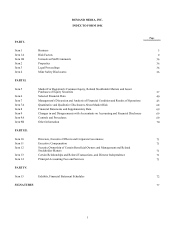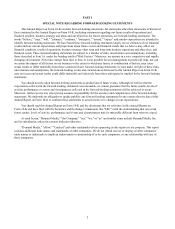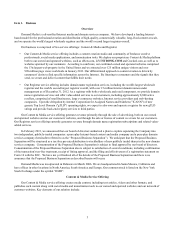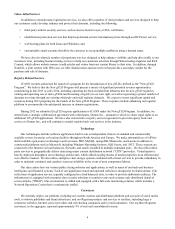Enom 2012 Annual Report Download - page 16
Download and view the complete annual report
Please find page 16 of the 2012 Enom annual report below. You can navigate through the pages in the report by either clicking on the pages listed below, or by using the keyword search tool below to find specific information within the annual report.11
search engines (and a majority of the traffic from search engines came from Google), according to our internal data. Our ability
to maintain the number of visitors directed to our owned and operated websites and to our customers' websites through which
we distribute our content by search engines is not entirely within our control. Some of our owned and operated websites and
our customers' websites have experienced fluctuations in search result rankings and we cannot provide assurance that similar
fluctuations may not continue to occur in the future.
Changes in the methodologies or algorithms used by Google or other search engines to display results could cause our
owned and operated websites or our customers' websites to receive less favorable placements or be removed from the search
results. Internet search engines could decide that content on our owned and operated websites and on our customers' websites,
including content that is created by our freelance creative professionals, is unacceptable or violates their corporate policies. It
is also possible that we could make changes to our existing websites or those of our customers that Google or other search
engines could view unfavorably and thereby cause a decrease in search referral traffic.
Google, the largest provider of search engine referrals to the majority of our owned and operated websites, regularly
deploys changes to its search engine algorithms. These changes have led the Company to experience fluctuations in the total
number of Google search referrals to its owned and operated and network of customer websites. In 2011, the overall impact of
these changes on the Company's owned and operated websites was negative, primarily due to a decline in traffic to eHow.com,
the Company's largest website. In 2012, Google continued to make changes to its search engine algorithms; however, we do not
believe that these changes in the aggregate had an overall negative impact on our traffic.
There cannot be any assurance as to whether these changes or any future changes that may be made by Google or any other
search engines might further impact our content and media business. Any reduction in the number of users directed to our
owned and operated websites and to our customers' websites would likely negatively affect our ability to earn revenue. If traffic
on our owned and operated websites and on our customers' websites declines, we may also need to resort to more costly
sources to replace lost traffic, and such increased expense could adversely affect our business, revenue, cash flows, financial
condition and results of operations.
We base our capital allocation decisions primarily on our analysis of the predicted internal rate of return on content. If the
estimates and assumptions we use in calculating internal rate of return on content are inaccurate, our capital may be
inefficiently allocated. If we fail to appropriately allocate our capital, our growth rate and financial results will be adversely
affected.
We invest in content and content formats based on our calculation of the internal rate of return on previously published
content cohorts for which we believe we have sufficient data. For purposes of these calculations, a content cohort is typically
defined as all of the content we publish in a particular quarter. We calculate the internal rate of return on a cohort of content as
the annual discount rate that, when applied to the advertising revenue, less certain direct ongoing costs, generated from the
cohort over a period of time, produces an amount equal to the initial investment in that cohort. Our calculations are based on
certain material estimates and assumptions that may not be accurate. Accordingly, the calculation of internal rate of return may
not be reflective of our actual returns. The material estimates and assumptions upon which we rely include estimates about
portions of the costs to create content and the revenue allocated to that content. We make estimates regarding when revenue for
each cohort will be received. Our internal rate of return calculations are highly dependent on the timing of this revenue, with
revenue earned earlier resulting in greater internal rates of return than the same amount of revenue earned in subsequent
periods.
We use more estimates and assumptions to calculate the internal rate of return on video content because our systems and
processes to collect historical data on video content are less robust. As a result, our data on video content may be less reliable.
If our estimates and calculations do not accurately reflect the costs or revenue associated with our content, the actual internal
rate of return of a cohort may be more or less than our estimated internal rate of return for such cohort. In such an event, we
may misallocate capital and our growth, revenue, financial condition and results of operations could be negatively impacted.
We face significant competition to our Content & Media service offering, which we expect will continue to intensify, and we
may not be able to maintain or improve our competitive position or market share.
We operate in highly competitive and still developing markets. We compete for advertisers and customers on the basis of a
number of factors including return on marketing expenditures, price of our offerings, and ability to deliver large volumes or
precise types of customer traffic. This competition could make it more difficult for us to provide value to our consumers, our
advertisers and our freelance creative professionals and result in increased pricing pressure, reduced profit margins, increased
sales and marketing expenses, decreased website traffic and failure to increase, or the loss of, market share, any of which would
























